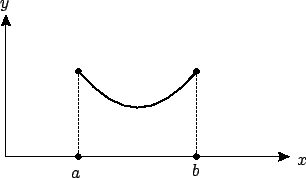 |
Suppose that a chain of a given length, with uniform mass density, is suspended freely between two fixed points (see Figure 2.3). What will be the shape of this chain? This question was posed by Galileo in the 1630s, and he claimed--incorrectly--that the solution is a parabola.
Mathematically, the chain is described by a continuous function
![]() , and the two suspension points are specified by endpoint constraints of the form
, and the two suspension points are specified by endpoint constraints of the form
![]() ,
, ![]() . The length
constraint is again given by (2.1).
In the figure we took
. The length
constraint is again given by (2.1).
In the figure we took ![]() and
and ![]() to be equal, and also assumed that the suspension points are high enough and far enough apart compared to the length
to be equal, and also assumed that the suspension points are high enough and far enough apart compared to the length ![]() so that the chain does not touch the ground (
so that the chain does not touch the ground (![]() for all
for all ![]() ).
The chain will take the shape of minimal potential energy. This amounts to saying that the
).
The chain will take the shape of minimal potential energy. This amounts to saying that the ![]() -coordinate of its center of mass should be minimized. Since the mass density is uniform, we integrate the
-coordinate of its center of mass should be minimized. Since the mass density is uniform, we integrate the ![]() -coordinate of the point along the curve with respect to the arclength and obtain the functional
-coordinate of the point along the curve with respect to the arclength and obtain the functional

(the actual center of mass is
The correct description of the catenary curve was obtained by Johann Bernoulli in 1691. It is given by the formula